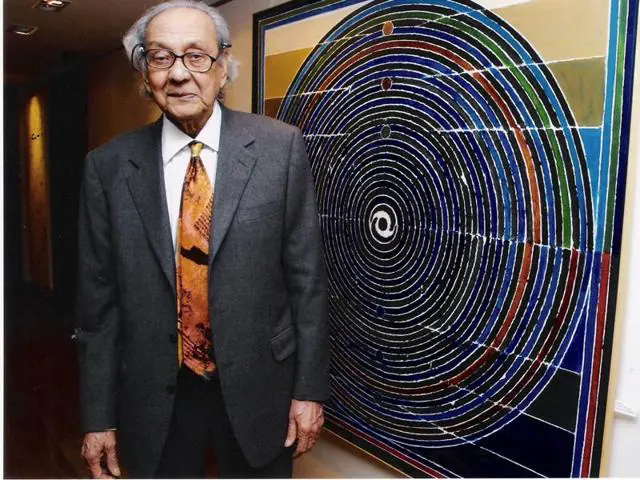
Sayed Haider was an Indian painter who lived and worked in France from 1950 until his death, while maintaining strong ties with India. Sayed Haider Raza was born in 1922 in the indian state of Madhya Pradesh. He started his career in the 1940s with expressionistic watercolours of his surroundings. In 1950, his life took an unexpected turn, when he won a French Government Scholarship and got the chance to study at the Ecole Nationale des Beaux-Arts in Paris. Here, he was exposed to different forms, coloration and composition techniques of the Post-Impressionists and discovered oil painting.
Thereafter, he continued to create landscapes inspired by the works of renowned artists like Cézanne, Gauguin and Van Gogh, and began to use colour as a tool of construction, switching from gouache and watercolour to more tactile oil-based pigments.
After his studies, he travelled across Europe, and continued to live and exhibit his work in Paris. He was later awarded the Prix de la critique in Paris in 1956, becoming the first non-French artist to receive the honour.
As one of the foremost pioneers of Indian modern art, his paintings blended Parisian modernism with the colours of Indian Rajput art. He is considered to be one of the most important 20th-century painters.
Inspiration and Subject Matter
The most tenacious memory of Raza’s childhood was the fear and fascination of Indian forests. He lived near the source of the Narmada river in the centre of the dense forests of Madhya Pradesh. The nights in the forests were hallucinating; sometimes the only humanising influence was the dancing of the Gond tribes. Only the daybreak brought back a sentiment of security and wellbeing. On market day, under the radiant sun, the village was a fairyland of colours. Till his last days, he found these aspects of his life dominate his paintings thematically.
Rooted in his childhood memories over time his landscapes became increasingly abstract.
Progressive Art Movement
He was a co-founder of the Progressive Artists Group (PAG) which was established in 1947, in Bombay. It was a collective of some of the most awe-inspiring Indian artists who diverted from and challenged the conventional artistic sensibilities of the time to espouse a global mindset.
An attempt to break away from the revivalist nationalism endorsed by the Bengal School of Art, the PAG emerged out of the disdain and shock of the brutality that accompanied the partition of India. Its impetus was the creation of an Indian form of modernism that combined pluralism of Indian art history with modern European styles such as post-impressionism. expressionism and cubism.
Apart from Raza the founding members of PAG included F.N. Souza, M.F. Husain, K.H. Ara, S.K. Bakre, and H.A. Gade. Author Mulk Raj Anand praised them as the ‘heralds of a new dawn in the world of Indian art.
Innovative Ideation
Raza explored the themes of Prakriti (nature), Kundalini (primal energy), Tribhuj (triangle) and Bindu (circle/dot) through his work.
His most celebrated series was Bindu. Conceptually derived from the Sanskrit word “Shunya”, which has a spiritual connotation of being in a supreme state of awareness where everything comes to nothingness.
To him Bindu was the centre of all creation, a source of energy and life.
His best-known works are densely geometric, reminiscent of abstract pioneers like Wassily Kandinsky, inviting viewers into complex spatial and emotional interactions with his canvases.
In Passion: Life and Art of Raza, an autobiographical work he co-authored with Ashok Vajpeyi, the artist elucidates how the idea of Bindu which many would agree is the leit motif in his art was introduced to him by his school headmaster.
In the book he recalls, how worried about the wandering nature of his student, Nand Lal Jharia, the headmaster, summoned him and asked him to forget about everything and just concentrate on the dot he made on the board.
Raza returned to India in 2010 after living in France for six decades. France had an important influence on his painting style, but the object of his art remained closely related to India.
The archetypical Indian spirituality and tradition that Raza brought to his canvas by contrasting different colours spoke of the artist’s sincere devotion towards his people and culture. His art was his voice, his vision and his legacy.
Picture Credit : Google




